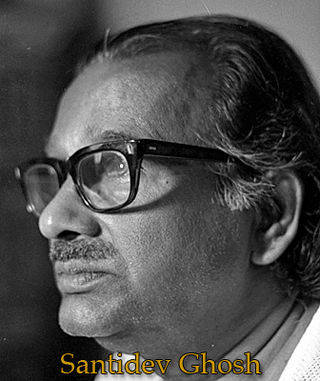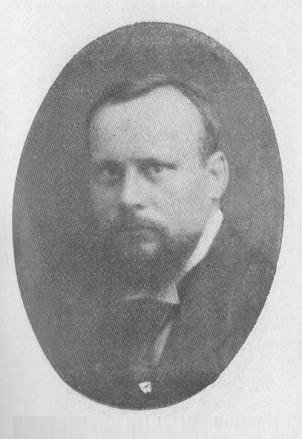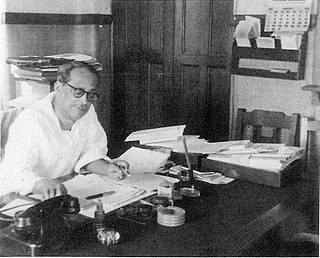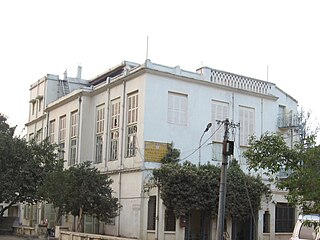
Shantiniketan is a neighbourhood of Bolpur town in the Bolpur subdivision of Birbhum district in West Bengal, India, approximately 152 km north of Kolkata. It was established by Maharshi Devendranath Tagore, and later expanded by his son, Rabindranath Tagore whose vision became what is now a university town with the creation of Visva-Bharati.

Hazari Prasad Dwivedi was a Hindi novelist, literary historian, essayist, critic and scholar. He penned numerous novels, collections of essays, historical research on medieval religious movements of India especially Kabir and Natha Sampradaya, and historical outlines of Hindi literature.

Visva-Bharati, is a public central university and an Institute of National Importance located in Shantiniketan, West Bengal, India. It was founded by Rabindranath Tagore who called it Visva-Bharati, which means the communion of the world with India. Until independence it was a college. Soon after independence, the institution was given the status of a central university in 1951 by an act of the Parliament.

Patha Bhavana is an institution of primary and secondary education in Santiniketan, West Bengal, India. Founded by Nobel laureate Rabindranath Tagore in 1901, starting with only five students, the school is characterized by its philosophy of learning with the heart in closeness to nature without any superficial barriers between teachers and students, as opposed to the strict, repetitive and the rote learning system that was mainstream during Tagore's childhood. Often referred to as an ashram system, initially what started out as this school, later grew into what is now Visva-Bharati University. It is one of the two primary and secondary school affiliated with the Visva-Bharati University; the other being Siksha Satra.

Suchitra Mitra was an Indian singer, composer, artist exponent of Rabindra Sangeet or the songs of Bengal's poet laureate Rabindranath Tagore, professor, and the first woman Sheriff of Kolkata. As an academic, she remained a professor and the Head of Rabindra Sangeet Department at the Rabindra Bharati University until 1984. Mitra was a playback singer in Bengali films and was associated for many years with the Indian People's Theatre Association.

Santidev Ghose was an Indian author, singer, actor, dancer and maestro of Rabindra Sangeet.
Tan Chung is an authority on Chinese history, Sino-Indian relations and cultural exchange. He has been a doyen of Chinese cultural studies in India for nearly half a century.
Sriniketan is a neighbourhood of Surul in Bolpur subdivision of Birbhum district in the Indian state of West Bengal. It is adjacent to Santiniketan and houses the second campus of Visva-Bharati University. The Palli Samgathana Vibhag and Palli Siksha Bhavana are located in west bengal

Vincenc Lesný was a Czech professor and research scholar of Indology and Iranian Studies.

Prabodh Chandra Bagchi or P. C. Bagchi was one of the most notable Sino-Indologists of the 20th century. He was the third Upacharya (Vice-Chancellor) of Visva-Bharati University.

Sudhir Ranjan Khastgir was an Indian painter of Bengal school of art and an art educator. A pupil of Abanindranath Tagore and Nandalal Bose, Sudhir was known for "Indian style" of painting. He graduated from Visva-Bharati University at Santiniketan in 1929. He was influenced by the Tagore family and his classic works include paintings of scenes from Indian mythologies, women, and village life. He was also the first Art teacher at The Doon School, Dehradun, when it opened in 1935. Today, the many statues and murals on display at Doon, and frescoes of dancers at the entrance of a local cinema hall, 'The Orient', are a product of his creation.

Kala Bhavana is the fine arts faculty of Visva-Bharati University, in Shantiniketan, India. It is an institution of education and research in visual arts, founded in 1919, it was established by Nobel laureate Rabindranath Tagore.
Krishna Kripalani was an Indian freedom fighter, author and parliamentarian. He wrote a number of books on Rabindranath Tagore, Mahatma Gandhi and on Indian literature.
Banarsidas Chaturvedi was a noted Hindi-language writer, journalist and recipient of Padma Bhushan awarded by Government of India in 1973. He was born on 24 December 1892 in Firozabad in the North-Western Provinces of British India and died on 2 May 1985. He served as a nominated member of Rajya Sabha for twelve years.

Pratima Devi (1893–1969) was an Indian Bengali artist, widely known for her artistic abilities. She was wife of Rathindranath Tagore. The poet took special interest in developing her capabilities.
The following is a list of notable people associated withVisva- Bharati University and/or Santiniketan, a neighbourhood in Bolpur city in West Bengal, India:
Tan Yun-Shan was a Chinese scholar and founder of Santiniketan's Cheena Bhavana, the oldest centre of Chinese studies in South Asia. He devoted his life to the cause of Sino-Indian cultural friendship.
Jan Yun-hua (1923-2018) was a Chinese language researcher, teacher and author. He was associated with McMaster University in Canada.

Sangit Bhavana, of Visva-Bharati University, Santiniketan, started functioning as a part of Kala Bhavana in 1919 and as a separate institution in 1933. It was established by the Nobel laureate Rabindranath Tagore.

Palli Samgathana Vibhaga, of Visva-Bharati University, was established at Sriniketan in 1922, by the Nobel laureate Rabindranath Tagore. Leonard Knight Elmhirst was its first director.













